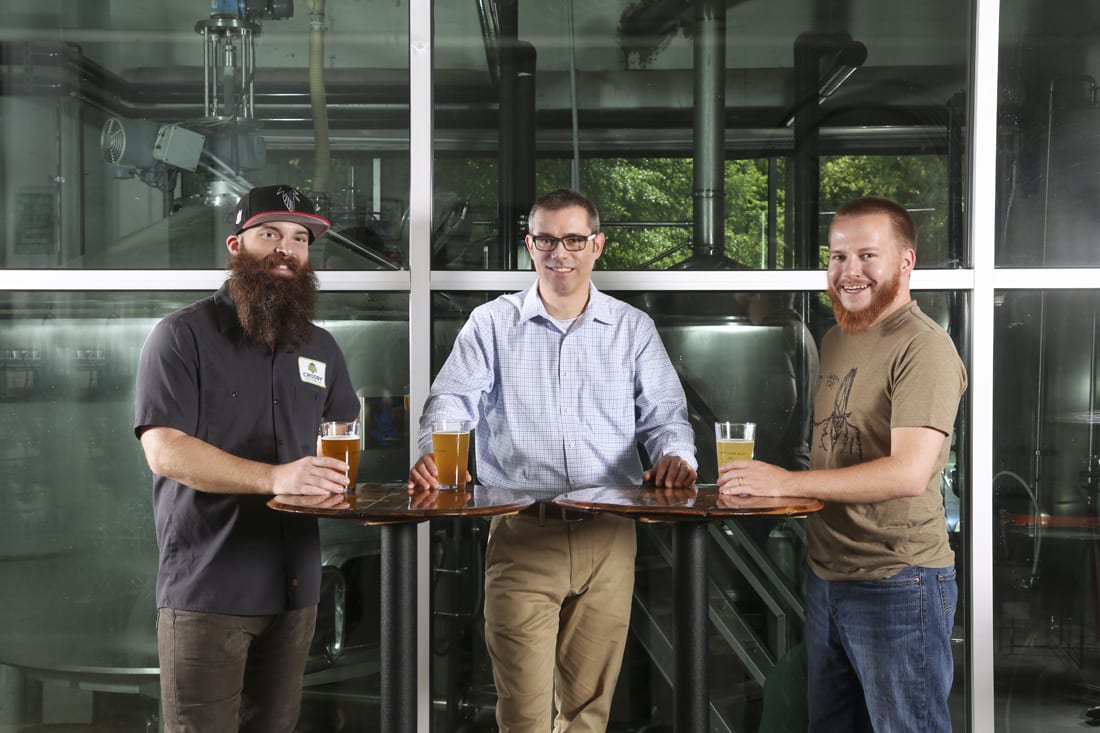Three local homebrewers discuss their craft

Half art, half science, homebrewing is a hobby that satisfies the curious, detail-oriented mind. Collectively, the estimated 1.2 million homebrewers in the U.S. produce more than 2 million barrels of brew a year. It’s like a grown-up chemistry set for expressing creativity. With a supportive beer community in Atlanta, the craft beer scene is burgeoning, and homebrewing is becoming increasingly popular. Here, we speak with three local brewers who live in Buckhead and Sandy Springs about their experiences making beer.
What is your day job and how do you find time to homebrew?
NATE WATKINS: I am a finance manager at Georgia Tech. I brew on weekends only and try to do one beer a month. The day we had ice this winter, I had a couple of days off. My homebrew club, Covert Hops, has a 55-gallon system. I made a commemorative beer: Not A Snow Day Scottish Ale. It was pretty good.
CAMERON ALME: I’m the assistant brewer at Orpheus. I brew, bottle or keg homebrewed beer on my days off. Sometimes I’m able to focus solely on the brew; most days I’m multitasking, such as walking my dog while the grain is being mashed.
CHRIS COLLIER: I am an IT director for a clothing company. I brew on weekends and rack beer [part of the fermentation process] on weeknights.
How did you get into homebrewing?
WATKINS: I started while I was an undergrad at Georgia Tech in 2008. In 2009, I switched [from extract brewing] to all-grain brewing, what commercial brewers do. At the time, I was brewing with college friends and just kept doing it. A great way to start is with a True Brew beer kit.
ALME: As a newly certified SweetWater tour guide, I was hoping to learn a little bit about the brewing process to more succinctly and adeptly describe it. Before that, my interest in craft beer was simply drinking it.
COLLIER: I have been brewing since ’96 when my parents gave me a homebrew kit for Christmas. Until they raised the 6% [alcohol content] law, I couldn’t get Belgian or high-gravity beers. I thought, “Hey, I can brew them myself.” I joined Covert Hops, and we get together and share recipes and ideas.
What do you like to brew?
WATKINS: I tend to go for malty beers. A recent kick is English styles with low alcohol. It’s something I can drink a lot of. When my soccer team [Newcastle] was on a hot streak, I made an English brown ale and called it Mitro’s on Fire!
ALME: I’ve been brewing a ton of IPAs in the past year but have been gravitating towards more sessionable [low alcohol] pale ales and milds as of late.
COLLIER: Hop-forward, pale ales, a lot of sour stuff lately.
What are some of your successes and failures?
WATKINS: Multiple times a year, I make an old barley wine recipe. It won a medal at a homebrew competition. The first time I did a barley wine; my second attempt at all-grain didn’t work. I was going for an Irish red, but instead of 5.6%, I got 10% heavy barley. It was a happy accident.
ALME: All of my first attempts were pretty much failures but were crucial learning experiences that have led to my creating beer I can be proud to share in the last year or two. My favorite homebrews have been a Belgian dark ale, brown ale and India pale ale.
COLLIER: I have been working on a solera, a kind of sour in a barrel. My sours have been doing well in competitions. I have pretty much brewed every style. I experiment a lot. Other than yeast going everywhere/over-fermenting, my experiments have gone well.
Any serious plans for your brewing hobby?
WATKINS: Beyond beer, I do mead and started brewing cider. I am trying to broaden my horizons and experiment.
ALME: My [previous job as tasting room manager at SweetWater Brewing Company] led me to homebrewing beer, but my casual hobby quickly turned into an obsession. I’ve spent years promoting beer, and [I’m now producing] beer for Orpheus Brewing Company. Definitely a long way from the first extract kit and confusing the cleaner from the sanitizer.
COLLIER: I co-founded Nantahala Brewing in North Carolina in 2009, then sold it. I am a consultant, brewing at Hopstix [a small brewery in Chamblee]. My long-term vision is to do my own thing—a brewery—or help someone who wants to do the same by leasing them equipment.
Favorite places to drink beer in Buckhead, Brookhaven and Sandy Springs?
WATKINS: Red Brick Brewery is my favorite place. I dig Kaleidoscope Pub. The beer selection at Saltyard is pretty phenomenal.
ALME: SweetWater. And Kaleidoscope for the intriguing menu and craft beer selection.
COLLIER: The Chapter Room under Taco Mac at the Prado.
Basic Steps to Make Beer
1. Malted barley is soaked in hot water to release malt sugars.
2. Malt sugar solution is boiled with hops for seasoning.
3. Mort (unfermented ale) is cooled, and yeast is added to begin fermentation.
4. Yeast ferments the sugars, releasing CO2 and ethyl alcohol.
5. When main fermentation is complete, beer is bottled with a little added sugar for fermentation.
STORY: Angela Hansberger
PHOTO: Sara Hanna















